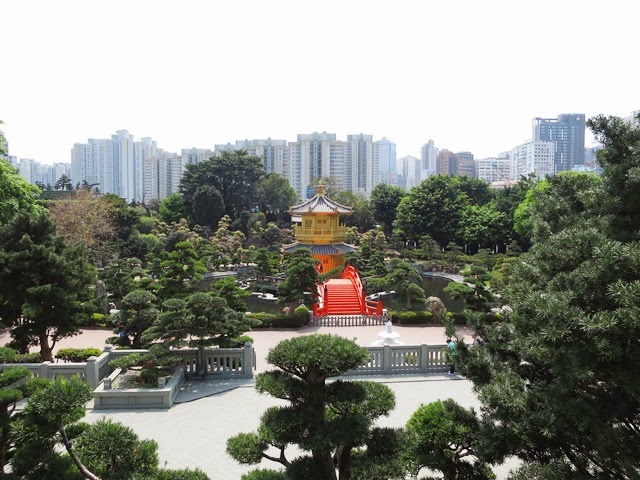Today’s expedition was
just seven stops away on the MTR (Mass Transit Railway, Hong Kong’s uber-modern
and efficient underground system). We got off at Diamond Hill station and
within a few minutes were at the entrance to Nan Lian Garden.
The Garden is a 35,000
square metre public park designed and built by the Chi Lin Nunnery and opened
eight years ago. It was built in the classical style of the Tang Dynasty (AD 618-907)
and the hills, water features, rocks, plants and timber buildings all reflect
the principles of Tang landscaping and architecture. It aims to be a haven of
serenity and tranquillity – although it is surrounded by several high-density,
high-rise housing estates!
In fact, the story of
today’s visit is the amazing way that Hong Kong builds cultural oases in the
midst of its urban desert.
For example, turn a
corner and there is a colourful pagoda set in the middle of a small lake.
Stand back and you will
notice several twenty-first century concrete ‘pagodas’
rearing up from a nearby housing estate.
A path winds through
the garden, passing old trees trimmed into fantastic shapes like huge bonsai, ancient
rocks moulded over time into bizzare shapes, lakes with monster goldfish, fountains and waterfalls.
Every time you want to
take a photograph of something, like this tranquil scene at the end of a lake,
you must frame it very carefully.
- Or else the concrete
towers of the twenty-first century will intrude!
We passed a large waterfall and beside it a water mill with a wheel turning slowly.
Looking closer at the 'waterfall' we noticed that it concealed a restaurant! Behind the falling water were tables of people enjoying a vegetarian lunch...
Towards the end of the
route there was a little museum of rocks and a beautiful, high quality gift shop.
Then it was time to leave the Garden. We passed the pagoda once more, and took a photo from the other side.
And one showing it in its surroundings...
Leaving the Garden, we walked up an overpass and into the grounds of Chi Lin Nunnery, the Buddhist complex responsible for managing the Garden. It's a huge operation, including a nunnery, temple halls, hospital, visitors' hostels, vegetarian restaurant and gift shop. To begin with, there is this impressive gatehouse which has its own cedar halls housing massive statues of Buddhist deities (unfortunately, there was a strict 'no photos' rule concerning the interior of all the halls in the complex).
Going through the gatehouse, the entire complex opened out, with the main building, a large temple, directly ahead.
Walking to the main temple we passed yet another museum of bizarre and weird boulders...
The nunnery was founded eighty years ago but was rebuilt in the 1990s based on traditional Tang architecture. It is famous for the the extensive use of wood - without the use of nails (instead it uses wooden dowels and bracket work to hold the 228,000 pieces of timber together). The sheer amount of wood used is impressive, it is warm in colour, polished to a rich mahogany. The nunnery itself is well situated according to feng shui principles; back against a mountain and facing the sea.
The main temple comes into view. Its main hall is spectacular, wood paneled with 18 cedar columns to hold up the roof - no mean feat since the clay roof tiles weigh 176 tons! But it is the statues that hold the attention. They are spectacular; huge, golden, gleaming, rearing up towards the high intricately-carved ceiling. In the centre is the largest statue, the first Buddha, known as Sakyamuni, seated on a golden lotus throne, with two lesser gilt statues on each side of him. I gazed at it for quite a while, thinking that it was probably a good idea that photography was banned, a digital image could not do justice to the image before me. Mind you, I was tempted...but I behaved and kept the camera in my pocket.
Then it was time to leave and take one last photographic record of the Hong Kong paradox; the juxtaposition of the spirit and concrete, the nunnery and its garden surrounded by the city, a part of it - but apart from it.



.JPG)



















No comments:
Post a Comment